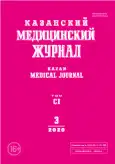Первый опыт одно- и двухэтапной эндоскопической подслизистой диссекции колоректальных неопластических образований
- Авторы: Сайфутдинов И.М.1, Славин Л.Е.1,2, Хайруллин Р.Н.1, Мухарямов М.Н.1,3, Зимагулов Р.Т.1, Иванов А.И.2,4, Панасюк М.В.1, Сайфутдинова Д.И.3, Иванов И.А.5
-
Учреждения:
- Межрегиональный клинико-диагностический центр
- Казанская государственная медицинская академия
- Казанский государственный медицинский университет
- Республиканский клинический онкологический диспансер
- Казанский (Приволжский) федеральный университет
- Выпуск: Том 101, № 3 (2020)
- Страницы: 446-451
- Тип: Обмен клиническим опытом
- URL: https://journals.rcsi.science/kazanmedj/article/view/19443
- DOI: https://doi.org/10.17816/KMJ2020-446
- ID: 19443
Цитировать
Полный текст
Аннотация
Цель. Представить первый опыт одно- и двухэтапной эндоскопической подслизистой диссекции колоректальных образований.
Методы. За период с 2018 по 2019 гг. 17 пациентам (6 мужчинам и 11 женщинам) в возрасте от 33 до 79 лет выполнена 21 эндоскопическая подслизистая диссекция колоректальных образований размерами от 1,0 до 6,0 см. Подслизистые образования выявлены у 2 (11,8%) пациентов, эпителиальные образования — у 15 (88,2%) человек, из них латерально распространяющиеся опухоли — у 9 (60%), полипы на широком основании — у 6 (40%) пациентов. По результатам гистологического исследования выявлены карциноид (11,8%), аденомы с интраэпителиальной неоплазией низкой (64,7%) и высокой (23,5%) степеней. 13 пациентам операция выполнена в один этап, 4 больным потребовалось два эндоскопических этапа с однодневным промежутком. У всех пациентов в среднем через 2 и 6 мес после операции выполнены контрольные осмотры.
Результаты. Подслизистая диссекция единым блоком выполнена у 11 (64,7%) пациентов, у 4 из них в сочетании с резекций слизистой оболочки. У 6 (35,3%) осуществлена фрагментарная резекция образования. Продолжительность всех операций составила от 40 до 320 мин, в среднем 155±73 мин. Интраоперационные осложнения, которые устранены эндоскопически, отмечены во время проведения 8 (38,1%) из 21 операции: интенсивное кровотечение — 6 (75%), диастаз мышечных волокон — 1 (12,5%), перфорация стенки кишки — 1 (12,5%) случай. Через 6 мес у всех пациентов в области выполненной операции сформировался рубец, при этом 3 пациентам через 2 мес после операции потребовалось эндоскопическое удаление резидуальной аденоматозной ткани.
Вывод. Эндоскопическая подслизистая диссекция служит эффективным методом удаления колоректальных неопластических образований, а диссекция в два этапа — перспективный подход на этапе освоения методики.
Полный текст
Открыть статью на сайте журналаОб авторах
Ильяс Маратович Сайфутдинов
Межрегиональный клинико-диагностический центр
Автор, ответственный за переписку.
Email: Isayfutdinov@mail.ru
SPIN-код: 6771-5167
Россия, г. Казань, Россия
Лев Ефимович Славин
Межрегиональный клинико-диагностический центр; Казанская государственная медицинская академия
Email: Isayfutdinov@mail.ru
SPIN-код: 3862-2719
Россия, г. Казань, Россия; г. Казань, Россия
Рустем Наилевич Хайруллин
Межрегиональный клинико-диагностический центр
Email: Isayfutdinov@mail.ru
SPIN-код: 1146-7585
Россия, г. Казань, Россия
Мурат Наилевич Мухарямов
Межрегиональный клинико-диагностический центр; Казанский государственный медицинский университет
Email: Isayfutdinov@mail.ru
SPIN-код: 1599-4115
Россия, г. Казань, Россия; г. Казань, Россия
Рустем Талгатович Зимагулов
Межрегиональный клинико-диагностический центр
Email: Isayfutdinov@mail.ru
Россия, г. Казань, Россия
Алексей Игоревич Иванов
Казанская государственная медицинская академия; Республиканский клинический онкологический диспансер
Email: Isayfutdinov@mail.ru
SPIN-код: 3880-8570
Россия, г. Казань, Россия; г. Казань, Россия
Михаил Валентинович Панасюк
Межрегиональный клинико-диагностический центр
Email: Isayfutdinov@mail.ru
ORCID iD: 0000-0003-2884-8815
SPIN-код: 8906-2240
Scopus Author ID: 55984522900
ResearcherId: O-9732-2015
Россия, г. Казань, Россия
Дина Ильясовна Сайфутдинова
Казанский государственный медицинский университет
Email: Isayfutdinov@mail.ru
Россия, г. Казань, Россия
Игорь Алексеевич Иванов
Казанский (Приволжский) федеральный университет
Email: Isayfutdinov@mail.ru
Россия, г. Казань, Россия
Список литературы
- Piessevaux H. How to predict and achieve success with a very long procedure in an endoscopy unit: Is it time for a break? Endosc. Int. Open. 2019; 7 (9): E1097–E1098. doi: 10.1055/a-0889-7945.
- Watanabe T., Itabashi M., Shimada Y. et al. Japanese Society for Cancer of the Colon and Rectum (JSCCR) Guidelines 2014 for treatment of colorectal cancer. Int. J. Clin. Oncol. 2015; 20 (2): 207–239. doi: 10.1007/s10147-15-0801-z.
- Kiriyama S., Saito Y., Yamamoto S. et al. Comparison of endoscopic submucosal dissection with laparoscopic-assisted colorectal surgery for early-stage colorectal cancer: a retrospective analysis. Endoscopy. 2012; 44 (11): 1024–1030. doi: 10.1055/s-0032-1310259.
- Еmmanuel A., Gulati S., Burt M. et al. Сolorectal endoscopic submucosal dissection: patient selection and special considerations. Clin. Exp. Gastroenterol. 2017; 10: 121–131. doi: 10.2147/CEG.S120395.
- Hotta K., Fujii T., Saito Y., Matsuda T. Local recurrence after endoscopic resection of colorectal tumors. Int. J. Colorectal. Dis. 2009; 24 (2): 225–230. doi: 10.1007/s00384-008-0596-8.
- Hotta K., Oyama T., Shinohara Y. et al. Learning curve for endoscopic submucosal dissection of large colorectal tumors. Dig. Endosc. 2010; 22 (4): 302–306. doi: 10.1111/j.1443-1661.2010.01005.x.
- Sakamoto T., Saito Y., Fukunaga S. et al. Learning curve associated with colorectal endoscopic submucosal dissection for endoscopists experienced in gastric endoscopic submucosal dissection. Dis. Colon Rectum. 2011; 54 (10): 1307–1312. doi: 10.1097/DCR.0b013e3182282ab0.
- Hisabe T., Nagahama T., Hirai F. et al. Clinical outcomes of 200 colorectal endoscopic submucosal dissections. Dig. Endosc. 2012; 24 (1): 105–109. doi: 10.1111/j.1443-1661.2012.01267.x.
- Nishiyama H., Isomoto H., Yamaguchi N. et al. Endoscopic submucosal dissection for laterally spreading tumors of the colorectum in 200 consecutive cases. Surg. Endosc. 2010; 24 (11): 2881–2887. doi: 10.1007/s00464-010-1071-5.
- Yoshida N., Wakabayashi N., Kanemasa K. et al. Endoscopic submucosal dissection for colorectal tumors: technical difficulties and rate of perforation. Endoscopy. 2009; 41 (9): 758–761. doi: 10.1055/s-0029-1215028.
- Tanaka S., Toyonaga T., Morita Y. et al. Feasibility and safety of endoscopic submucosal dissection for large colorectal tumors. Surg. Laparosc. Endosc. Percutan. Tech. 2015; 25 (3): 223–228. doi: 10.1097/SLE.0000000000000135.
- Jung D.H., Youn Y.H., Kim J.H., Park H. Endoscopic submucosal dissection for colorectal lateral spreading tumors larger than 10 cm: is it feasible? Gastrointest. Endosc. 2015; 81 (3): 614–620. doi: 10.1016/j.gie.2014.09.001.
- Kawaguti Fabio S., Okazaki Ossamu, Miyajima Nelson T. et al. Two-step ESD: an option for en-bloc resection of extensive colorectal laterally spreading tumors. Endosc. Int. Open. 2019; 7 (9): E1092–E1096. doi: 10.1055/a-0887-4294.
Дополнительные файлы
















